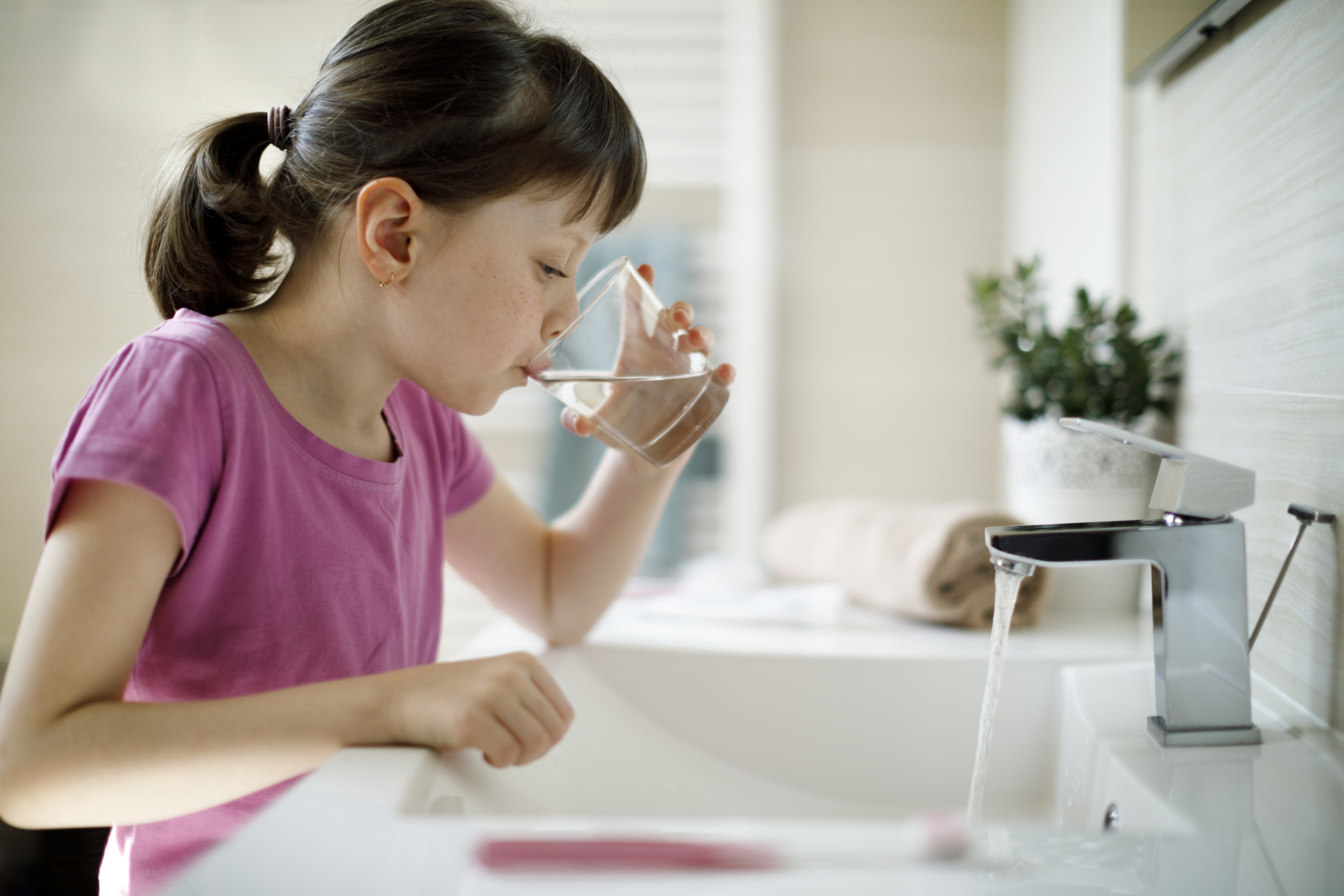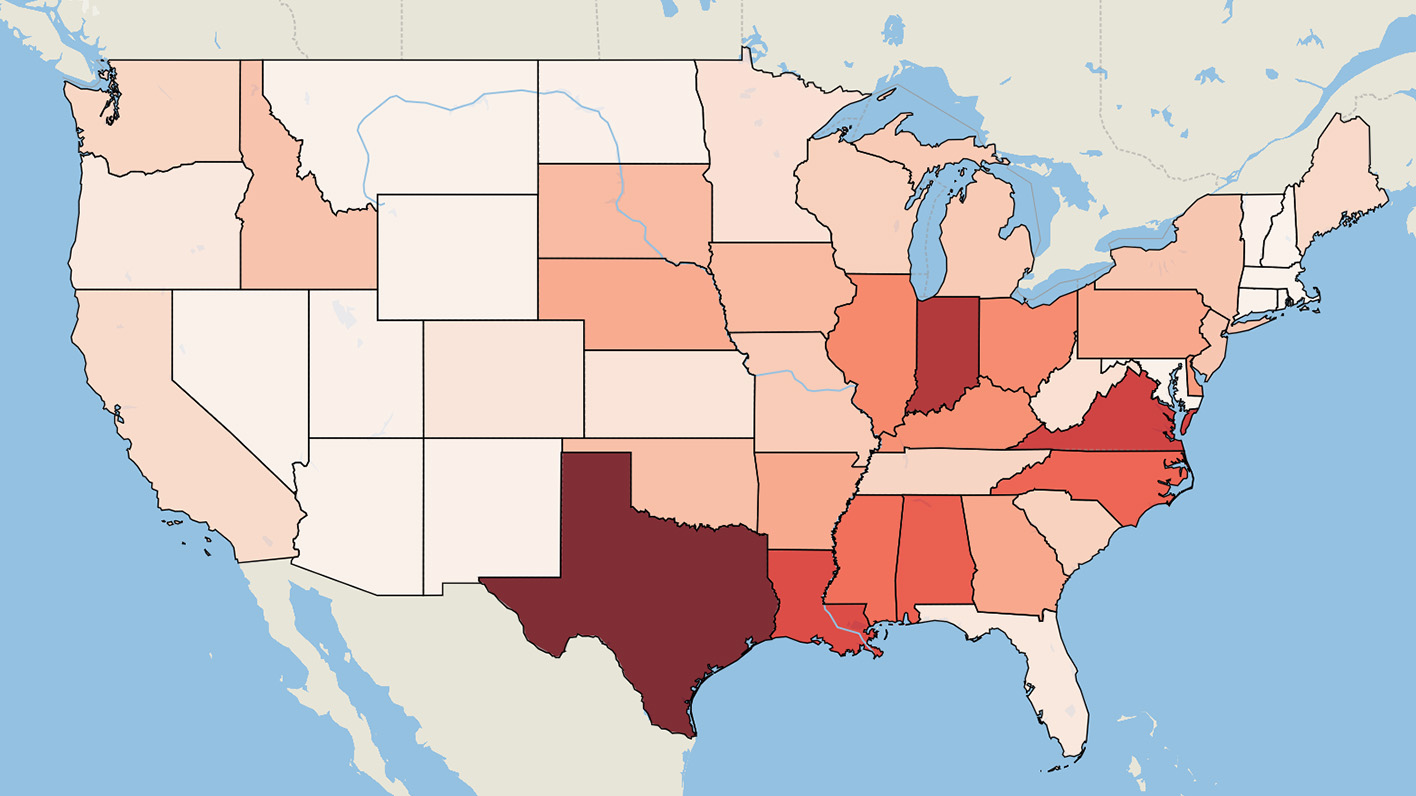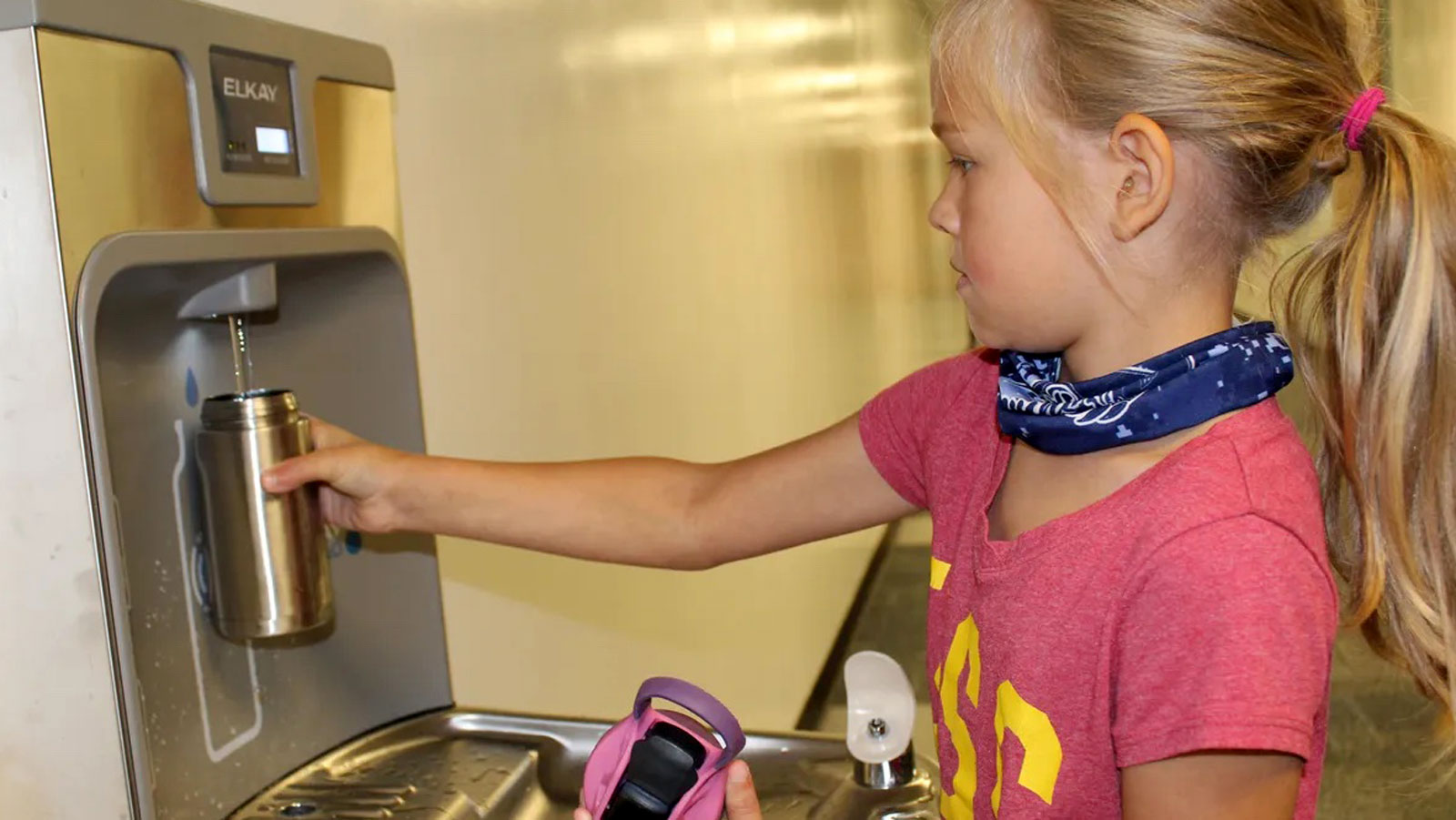
Lead in schools’ water
Test results now show that lead is even contaminating drinking water in schools and preschools — flowing from thousands of fountains and faucets where our kids drink water every day.
Our children need safe drinking water — especially at school where they go to learn and play each day. Yet as our map below shows, lead is contaminating drinking water at schools and preschools across the country.
Lead is highly toxic for children. Instead of more testing, schools should install filters at every drinking water tap and replace lead-bearing fountains, faucets and plumbing, which put kids’ health at risk.
Recommendations
The science now makes clear that there is no safe level of lead exposure for our children. So, to ensure safe drinking water for our children, we need policies that are strong enough to “get the lead out” at schools and preschools.
States and communities should:
- Proactively “get the lead out” of schools and child care centers by replacing fountains, faucets and other parts containing lead.
- Install and maintain filters certified to remove lead on every faucet or fountain used for cooking and drinking.
- Adopt a 1 part per billion (ppb) standard for lead in schools’ drinking water, consistent with recommendations of the American Academy of Pediatrics.
- Require testing at all water outlets used for drinking or cooking at all schools annually, using protocols designed to capture worst-case lead exposure for children.
- Immediately remove from service any faucet or fountain used for drinking or cooking where testing indicates lead in the water.
- Disclose all available information about lead in water infrastructure, test results and remediation plans/progress both onsite and online.
- Provide funding to remove lead in schools’ water infrastructure.
The federal government should:
- Enforce and strengthen federal rules to protect drinking water from lead — e.g. the Lead and Copper Rule.
- Provide major funding to help states and communities remove lead in water infrastructure — including lead service lines and plumbing/fixtures in schools.
- Marshal the authority of all relevant federal agencies to protect public health from contamination of drinking water. And of course, we should fully protect all sources of drinking water from pollution.
Sources
AK: Environmental Protection Agency, news release, November 23, 2021, accessed online on 2/27/22 at [LINK]
AR: Joseph Flaherty, “State to check schools’ water for lead levels,” Arkansas Democrat Gazette, February 24, 2020, accessed online on 2/27/22 at [LINK]
AL: Alabama Department of Environmental Management, “2017-2019 ADEM Lead Testing in Public Schools Program,” accessed online on 2/27/22 at [LINK]; Alabama Department of Environmental Management, Lead Testing in Schools Results, accessed online on 2/27/22 at [LINK]
AZ: Arizona Department of Environmental Quality, Arizona’s Public School Drinking Water Lead Screening Program, December 2017, accessed at [LINK] See Initial Screening chart on page 7
Arizona Department of Environmental Quality, Public School Lead Screening Test Data, last revised December 8, 2017 [LINK]
CA: CALPIRG, Get the Lead Out Statewide Map, revised March 3, 2020, accessed at [LINK] California Water Boards, “Lead Sampling of Drinking Water in California Schools,” California Water Boards, last modified December 31, 2020; and testing results obtained by CALPIRG from the California State Water Board, accessed at [LINK]; California Natural Resources Agency, “Drinking Water – Results of Lead Sampling of Drinking Water in California Schools,” revised February 28, 2022, accessed at [LINK]
CO: Denver Public Schools, Lead Testing Results [LINK]. Other school districts’ water testing up to 2021 [LINK]
CT: Ana Radelat, “Most CT schools don’t test water for lead, but that could change,” The CT Mirror, April 1, 2016, accessed at [LINK]; AJ Walker, “Most Connecticut Schools Are Not Required to Test Water for Lead,” NBC Connecticut, August 17, 2016, accessed at [LINK]
DE: Jordan Howell, Delaware public school lead crisis getting worse by the day, Delaware Call, Feb. 24, 2023 [LINK]; and Delaware Lead in Drinking Water Sampling Dashboard [LINK]
FL: Eli Murray, Eli Zhang and Corey G. Johnson, “Did Hillsborough check your school for lead? Search our database,” The Tampa Bay Times, January 20, 2019, accessed at [LINK]; Florida Department of Environmental Protection, Voluntary Lead Testing Program for Schools and Childcare Facilities, accessed at [LINK]
GA: Fulton County: Will Robinson, “Unsafe lead levels found in fountains, sinks in 48 Fulton schools,” The Atlanta Journal-Constitution, January 26, 2017, accessed at [LINK]; Atlanta schools: Molly Bloom, “Elevated lead levels found in more Atlanta schools’ water,” Atlanta Journal-Constitution, July 13, 2016, accessible at [LINK]; Test results: Clean Water for Georgia Kids, RTI International, accessed at [LINK]
HI: State of Hawaii Department of Health, WIIN-Lead Testing Results, accessed at [LINK] State of Hawaii Department of Health, Lead in drinking water at selected Hawaii public schools and child care facilities linked to faucet fixtures no longer being used while monitoring continues, July 22, 2021, accessed at [LINK]
ID: James Dawson, “High Lead Levels Found In Water At More Than 20 Boise Schools – Here’s Where They Are,” Boise State Public Radio News, November 29, 2018, accessed at [LINK] and Boise School District Lead Information Center page, accessed on 3/9/22 at [LINK]
IL: Abe Scarr, “Analysis finds pervasive lead contamination in schools,” released September 26, 2018. Available at [LINK]
IN: Indiana Finance Authority, “Indiana Lead Sampling Program for Public Schools,” January 2019, accessed at [LINK]; Indiana General Assembly, House Bill 1265, July 1, 2020 [LINK]
IA: Lead in Drinking Water Test Report obtained from Des Moines Public Schools in January 2022. See also DMPS
“Drinking Water Lead Testing Program,” accessed at [LINK]
KS: U.S. EPA, EPA Awards Kansas $472,000 to Test for Lead in School Drinking Water, April 8, 2020, accessed on
2/27/22 at [LINK]; Allison Kite, “Report: Residents in Missouri, Kansas get drinking water from lead pipes at high rates,” The Joplin Globe, July 17, 2021, accessed at [LINK]
KY: AJ Greenfield, “Kentucky to receive $576K to identify lead sources in schools’ drinking water,” WTVQ, February 27, 2020, accessed on 2/27/22 at [LINK]
LA: Louisiana Department of Health, “School Water Testing Pilot Program,” accessed at [LINK]
ME: Maine Division of Environmental and Community Health, “Testing for Lead in School Drinking Water” [LINK].
MA: Massachusetts Department of Environmental Protection Drinking Water Program, “Lead and Copper in School Drinking Water Sampling Results,” Massachusetts Department of Environmental Protection [LINK]
MD: Maryland Department of the Environment, “Test Results for Public Schools Received and Verified as of February 7, 2022,” accessed on 2/27/22 at [LINK]
MI: Lori Higgins, “33 more Detroit schools have high lead, copper in drinking water,” Detroit Free Press, September 19, 2018, accessed on 2/27/22 at [LINK]; Jennifer Chambers, “Detroit schools get water stations that filter toxins,” The Detroit News, June 12, 2019, accessed on 2/27/22 at [LINK]
MN: Minneapolis Public Schools, “Lead in Water Safety Plan,” see tab at bottom of page to view test results for each school [LINK]
MS: Shea Stewart, “Partnering for Safer Mississippi Drinking Water,” University of Mississippi News, October 20, 2021 [LINK]; Mississippi State Extension, SipSafe Program [LINK]
MO: Saint Louis Public Schools, “Water Testing: Individual School Test Results as of August 25, 2016,” accessed at [LINK]
MT: Environment Montana Research & Policy Center, “Get the Lead Out: Lead Contamination in Montana’s Schools” (2018) [LINK]; Montana Department of Environmental Quality, “Drinking Water: Lead in Schools,” accessed at [LINK]
Montana Department of Environmental Quality, “School Lead Sampling Results,” accessed at [LINK]
NE: Ellis Wiltsey, “NDEE reports on lead levels in Nebraska schools & childcare centers,” KOLN, February 7, 2022 [LINK]; Nebraska Dept. of Health and Human Services, “Lead Data and Reports,” accessed on 2/8/22 at [LINK]
NH: Saskia Braden, “In First Statewide Tests for Lead in School Drinking Water, Not All Schools Measure Up,” Conservation Law Foundation, September 12, 2019, accessed at [LINK]; New Hampshire Department of Environmental Services, “Lead in Drinking Water at NH Schools and Child Care Centers” [LINK]
NJ: Environment America Research & Policy Center, “Lead found in water at half of schools taps tested in Bergen County, New Jersey,” news release, July 17, 2017 [LINK]; Environment New Jersey Research & Policy Center, “New Study: Lead contamination exceedingly common in Atlantic County school drinking water,” news release, March 2, 2022, accessed at [LINK]; Dustin Racioppi and Stacey Barchenger, “High lead levels in NJ school water add to need for action, Murphy and lawmakers say,” Trenton Bureau, September 26, 2019, accessed at [LINK]
NM: Albuquerque Public Schools, “APS continues to remedy elevated lead levels in water,” November 19, 2019,
accessed on 3/12/22 at [LINK]
NY: New York League of Conservation Voters Education Fund, “5 is the New 15: A Case for Reducing the Action Level for Lead in New York State’s Public School Drinking Water Program from 15 parts per billion (ppb) to 5 ppb” [LINK]; Nicole Greenfield, “At Least 82 Percent of New York Public Schools Have a Lead Problem,” Natural Resources Defense Council, November 15, 2018, accessed at [LINK]
NC: Ann Doss Helms, “CMS has now tested 3,000 water fixtures in 89 schools for lead. Here’s the tally,” December 14, 2018, [LINK]; Charlotte-Mecklenburg Schools, Water Testing Program, accessed on 3/8/22 at [LINK]; Jennifer Hoponick Redmon, “Lead in drinking water at North Carolina childcare centers,” (Environmental Research April 2020) accessed on 3/9/22 at [LINK]; Greg Barnes, “Tap water tests find nearly 1 in 10 licensed child care centers in North Carolina have unsafe lead levels,”
NC Health News, April 26, 2021, accessed at [LINK]; Clean Water for Carolina Kids, Program Summary, accessed on 2/27/22 at [LINK]
ND: U.S. Environmental Protection Agency, North Dakota Department of Environmental Quality Amendment
Notification, November 21, 2019, accessed at [LINK]
North Dakota Department of Environmental Quality, “Lead in Schools,” accessed at [LINK]
OH: Harvard T.H. Chan School of Public Health, “Early Adopters: State Approaches to Testing School Drinking Water for Lead – State Profile: Ohio” (2018) [LINK]
OK: Oklahoma Department of Environmental Quality, “Oklahoma Drinking Water Lead Testing in Public Schools & Child Care Facilities,” see “Testing and Reporting” tab at bottom of page, accessed at [LINK]
OR: Environment America, “Survey of Testing Results from 100 School Districts.”, [LINK]; Oregon Health Authority, “Drinking Water Test Results: Oregon Schools (2016)” accessed at [LINK]
PA: Laura Ungar, "Lead taints drinking water in hundreds of schools, daycares across USA,” USA Today, March 17, 2016, accessed at [LINK]; Women for a Healthy Environment, “State Of Environmental Health In PA Schools,” accessed at [LINK]; PennPIRG Education Fund, “New Study: Lead Contamination Common in Philly School Drinking Water,” news release, February 16, 2022, accessed at [LINK]
RI: Rhode Island Dept. of Health, Lead in School [LINK]
SC: South Carolina Department of Health and Environmental Control, Lead Testing in Schools and Child Care Programs, accessed at [LINK]; South Carolina Department of Health and Environmental Control, WIIN Grant Sampla Results (12/18/2021),
accessed at [LINK]; South Carolina Department of Health and Environmental Control, “DHEC Offers Free Testing for Lead in Drinking Water at Schools, Child Care Centers through Federal Grant,” news release, October 21, 2021, accessed at [LINK]
SD: South Dakota Department of Agriculture & Natural Resources, Lead in Schools, accessed at [LINK]
TN: Statewide: Marta Aldrich, “Nearly 100 Tennessee schools found high lead levels in their water. Is your school on the list?” Chalkbeat Tennessee, August 29, 2019, accessed at
[LINK] For metro Nashville: Phil Williams, “Tests Show Lead in Metro Schools Drinking Water,” News Channel 5, October 4, 2017 accessed at [LINK] and Phil Williams, “Flint Expert: MNPS Lead Tests Should Be ‘Thrown Right Into The Garbage’,” News Channel 5, May 23, 2018, accessed at [LINK]; School by school data: “MNPS Lead Raw Data,” accessed at [LINK].
TX: Environment Texas, “Unleaded Education,” news release, January 2022, accessible at [LINK]
Environment Texas, TexPIRG and COCO, “Unleaded Education,” January 2022, accessible at [LINK]
UT: Utah Department of Environmental Quality, Utah’s Lead-Free Learning Initiative, revised February 3, 2022, accessible at [LINK]; Emma Penrod, “Early testing reveals more than 200 Utah schools have lead in their drinking water — some at potentially dangerous levels,” The Salt Lake Tribune, August 28, 2017, accessible at [LINK]; Ginna Roe, “Lead found in water at 90% of Utah schools sampled, now DEQ wants to test it all,” KUTV, January 21, 2020, accessible at [LINK]
VT: State of Vermont General Assembly, “An act relating to testing and remediation of lead in the drinking water of schools and child care facilities,” 2019, draft language accessible at [LINK]; Vermont Official State Website, Lead in School and Child Care Drinking Water Results, with Summary accessible at [LINK] and specific school results at [LINK]; Vermont Official State Website, Lead in School Drinking Water Pilot, accessible at [LINK].
VA: Virginia State Law Portal, § 22.1-135.1. Potable water; lead testing, accessible at [LINK]
WA: Bruce Speight and John Rumpler, “Lead in the Water: Statewide Data Reveals Elevated Levels of Lead in School Drinking Water in Washington” (2019) [LINK]; Washington State Department of Health, Lead Test Results from Drinking Water in Schools, accessible at [LINK]; Legislature of the State of Washington, “An Act: Relating to taking action to address lead in school drinking water” [LINK]
Washington, DC: Sarah Anne Hughes, “D.C. Tested Public Schools’ Water for Lead. More Than 60 Had High Levels,” Washington City Paper, June 27, 2016, accessible at [LINK]; DC Public Charter School Board, Annual Water Testing for Lead, August 31, 2021, accessible at [LINK]; DC Department of General Services, Water Sampling Results for DC Public Schools, accessible at [LINK]
WV: U.S. EPA, “EPA Awards West Virginia Dept of Health and Human Resources $262,000 to test for lead in school drinking water,” April 1, 2020, accessed at [LINK]
WI: Milwaukee Public Schools, “Milwaukee Public Schools releases results of water quality testing,” December
16, 2016, accessed at [LINK]; Rock County: Wisconsin Environmental Public Health Tracking Program, “Evaluating the Risk of Lead in School Drinking Water,” accessed at [LINK] and Madison Public Schools, “Lead Water Testing,” accessed on 3/10/22 at [LINK]
WY: Wyoming Department of Environmental Quality, “Water Infrastructure Improvements for the Nation Act (WIIN Act), Section 2107 – Lead Testing in School and Child Care Facility Program,” 2019, accessed at [LINK]
Topics
Find Out More


Who are the top toxic water polluters in your state?

Green schools guide
